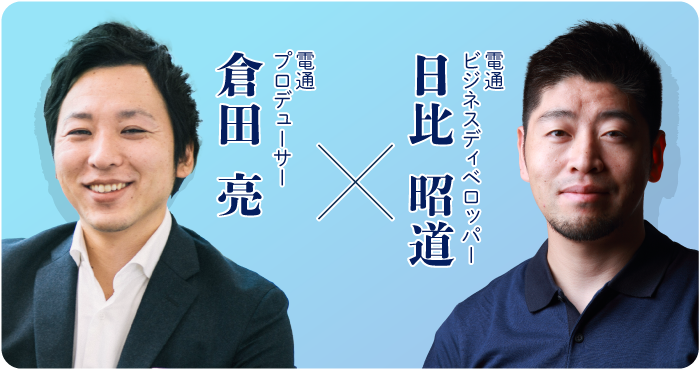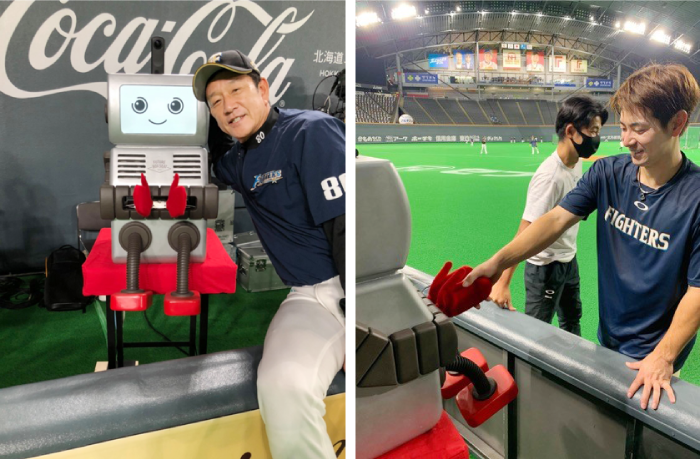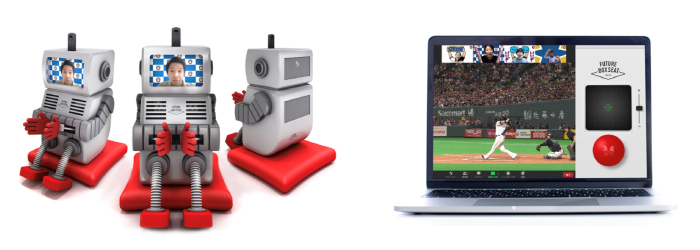Dentsu Inc.'s cross-functional creative organization, the "Future Creative Center" (FCC), is a group of over 70 members supporting future-building initiatives with creativity beyond the confines of advertising. This series features center members discussing their upcoming initiatives under the theme "Future × Creativity."
This installment focuses on the " Future Box Seatβ " project, a remote viewing experience utilizing robots. The system involves installing camera-equipped robots within the stadium, with a single robot's footage viewable by up to 1,000 people. Viewers can freely move the camera 360 degrees, choosing which players or view they want to see. It delivers an unprecedented "active viewing experience."
A proof-of-concept test was conducted during the official professional baseball game "Hokkaido Nippon-Ham Fighters vs. Chiba Lotte Marines" on July 14. How did this project, born in response to the COVID-19 pandemic situation, come to be? Mr. Akimichi Hibi of Dentsu Inc., involved in its development, and Mr. Ryo Kurata, seconded from Dentsu Inc. to Fighters Sports & Entertainment Inc., look back on the process.

*This interview was conducted online.
360-degree camera control and cheering for players. What is an "active" viewing experience?
Hibi: Future Box Seatβ was developed as a "future remote viewing seat" that lets you enjoy the game remotely as if you were there. Amid the pandemic, when attending sports events in person is difficult, it uses camera-equipped robots to let you watch the game through their footage.
What we want to provide is an "active viewing experience." While TV is certainly an option for remote viewing, despite its high quality, it doesn't allow you to freely choose which players or directions you want to watch. The project began with the goal of offering remote viewing that feels as active as watching live—like being able to follow your favorite players with your eyes. The camera can move freely in 360 degrees, and you can even send applause to the players through the robot.
Kurata: Fighters Sports & Entertainment Inc., the company that owns and operates the new Fighters stadium scheduled to open in 2023 and in which Dentsu Inc. has invested, participated by providing the venue for the proof-of-concept experiment. While I am seconded from Dentsu Inc., I work on various projects beyond the ballpark initiative and have been involved with Future Box Seatβ since its conceptual stage.
We first heard about the concept around late March. The Fighters couldn't have spectators due to COVID-19, and even looking ahead several years, it was unclear if they'd truly return to the previous style of spectating. With that awareness of the challenge, we moved quite quickly from the concept to the proof-of-concept experiment, right?
Hibi: Honestly, it's amazing we made it from the end-of-March concept to the July proof-of-concept... (laughs). The initial proposal we submitted to FCC was just a sketched idea. It was completely unknown how much we could actually develop it or whether it was even feasible. On the other hand, Dentsu Inc. has many partner companies. I felt there was potential to create something great by leveraging their capabilities and combining them with our creativity.
From concept to experiment in about three and a half months. What made this speed possible was "relationships."
Hibi: That said, the reason we got the green light at that conceptual stage was, above all, thanks to the Fighters' cooperation and the relationships Mr. Kurata had built while on secondment.
Kurata: You're absolutely right. I truly feel it was the Fighters' tremendous cooperation that made this possible, and I'm deeply grateful. Through numerous projects between the Fighters and Dentsu Inc., including the Ballpark Idea Workshop where Mr. Hibi also contributed, I believe both companies developed a relationship where we share the same direction and work together to create something good. It was precisely because of this accumulated trust that the Fighters established a cooperative framework even before we could show concrete outputs, allowing us to move forward with this sense of speed.
Amidst the rapid changes brought by the pandemic, speed in execution becomes crucial. This is especially true for projects involving multiple companies – how do you maintain that pace? While individual tasks can be expedited, building consensus across multiple companies while accelerating progress is no easy feat. What determines this is the relationship between the companies involved, and how flat that relationship can be. It's not a client-vendor dynamic; working together as partners is what creates speed. This project reinforced that strongly for me.
Hibi: Of course, having such an excellent production company join us was a huge factor. What struck me was the balance: not rigidly finalizing the plan before execution, but maintaining a 50/50 split between planning and execution. This agile development approach, where planning and execution happen simultaneously, also fosters new discoveries. The key concept that emerged this time, "active spectator experience," actually came about through development and testing.
Ideas are refined through execution. Therefore, I felt it was also good to evolve the initial idea as a core. Furthermore, I think it was significant that we FCC members strongly believed in the meaning and potential of this project and simply charged ahead. At that time, I believe it was Mr. Kurata who understood our desire to push forward and prepared the conditions to move forward.
The Value of Creativity That Leaps Forward, Standing Out in the New Normal
Hibi: I believe this case study succeeded through the convergence of three areas: technology, creativity, and the production role Mr. Kurata took on. In this era of the "new normal," where different values are paramount, bringing these three elements together feels critically important.
Regarding technology, the power of digital and IT is indispensable for avoiding contact risks. Its presence should grow even stronger than before. Furthermore, adding creativity to this mix will generate new perspectives and ideas.
Kurata: Amidst shifting societal norms and values, creativity can contribute to major transformations unbound by preconceptions. While this has been said in various contexts before, I believe this is precisely the value of creativity.
Hibi: At FCC, we call this "leap potential." While client companies manage existing business domains, we believe creativity comes alive to bring breakthroughs to those areas.
Incidentally, with Future Box Seatβ, the creative element also comes alive in the robot's "appearance." The production team deliberated meticulously and settled on a design that's simply endearing. That's because the presence or absence of charm changes how well it "fits into the space." Will the heroes on the field, like players and coaches, approach it? We really focused on this point.

Kurata: We also paid close attention to the "location" where the robot was placed during the proof-of-concept experiment. Instead of the regular spectator seats, we obtained special permission from relevant parties to install it in the broadcast camera seats. To truly impress upon people this new style of active spectating, we needed to show footage from an unprecedented viewpoint. That's precisely why placement in a high-impact location was essential. The camera seats offered proximity to the players, and with the Fighters' cooperation, players and coaches even approached the robot for commemorative photos. I believe this creative ingenuity was also key to conveying the project's value to the world.

Actual location where the robot was installed
To make it accessible for those who want to attend but can't make it to the venue
Hibi: Simultaneously, I believe the "production" element of the three factors I mentioned earlier is indispensable when discussing this project. While creativity is important, it often isn't enough on its own. Production acts as the bridge to realization. Regarding the installation location, it was crucial that Mr. Kurata communicated the project's significance to the Fighters and gained their understanding. Balancing creativity and production is vital.
Kurata: Creative ideas can sometimes be so far-fetched that they're hard to realize (laughs). However, I see the producer's role as aligning those ideas with what the client wants, the schedule, budget, cost-effectiveness, and so on, to land on a solution that makes everyone happy. In that sense, I think this project succeeded precisely because the creative and production sides collaborated closely from the very beginning.
This applies to FCC as a whole—the boundaries between roles like producer and creator are quite low. I freely offer opinions on creators' ideas, including on other projects, and actively step into their territory, so to speak (laughs).
Hibi: I sometimes take on production roles myself, but fundamentally, barriers are low across all projects. I believe that's one of FCC's strengths.
Kurata:Since Mr. Noritaka Obuse, the head of FCC , embodies this mindset, it's likely permeated and become ingrained throughout the entire center. I feel there's respect for each domain, but the barriers are kept to the absolute minimum.
Hibi: In that sense, I want us to keep combining creativity, production, and technology to create great things. Future Box Seatβ still has challenges, like video quality. Solving those and building a system where fans can easily take two-shot photos with players should add even more value.
Kurata: During our proof-of-concept testing, we were surprised to find athletes actually approached the robot with a sense of familiarity. The Fighters also commented that beyond COVID-19 measures, this could potentially be used by fans who live too far to attend games or those with physical disabilities that make live attendance difficult.
Hibi: Since up to 1,000 people can share the same camera feed simultaneously, scenarios like watching your alma mater's game with old club teammates from your student days are conceivable. Of course, it can also be used for sports other than baseball and for entertainment. We aim to enhance its functionality and establish it as the future standard for remote viewing. Furthermore, through this initiative, we hope to connect to the development of "engagement media" – media that fulfills the desires of core fans, essential for the coming era, beyond traditional mass media.











